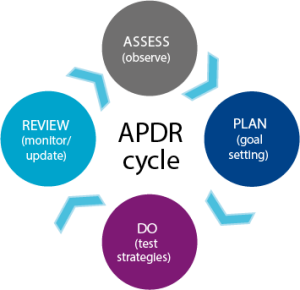I get a sinking feeling in my stomach when asked to provide quick sensory ideas which schools can use with their students. This is because there is no such thing as a ‘quick fix’ or a ‘simple solution’ to support sensory needs. Sensory processing is very complex. I’ve been studying it for 20 years and am still learning.
Instead of a quick fix, here are four key things you can consider, to make the sensory supports in your school more effective.
1) The Trigger
What is triggering the student’s arousal levels and behaviour? The term ‘arousal’ refers to the level of alertness or energy in the student’s body – these will fluctuate across the day and week and change with the environment or the activity.
Many things will impact a student’s arousal level. It could be something that happened earlier in the day or something that is happening in the future. It may be the environment or the activity that the student needs to do. Sleep, illness, and digestion also impact arousal levels.
2) Sensory training
Sensory supports are used in most schools, but only a fraction of staff have received training on using them effectively.
91% of educators and parents completing an introductory sensory training reported that they use sensory supports, but only 26% of them had previously attended sensory training1. A recent review cited that only 40% of SENCos had received training on sensory processing2, concluding that training on sensory processing should be included in the National SENCo qualification.
For supports to be fully understood, ALL staff supporting children with sensory needs will benefit from training.
3) Use the APDR cycle
I rarely see this used in schools when implementing sensory supports. If you are using this, I would love to hear from you as I am looking for examples!
APDR helps evaluate needs and impact of student’s progress. It stands for:
- Assess – assess the situation/student’s needs
- Plan – create a plan of action, including goals
- Do – implement your plan
- Review – review the impact the strategies had on the goal
The plan should include a time frame when it will be reviewed. Here’s two examples of how an APDR cycle may look for fidgety students.

Fidgety Student 1 Oliver
A: Oliver is fidgety and distracted directly before break, lunch and going home – he is the first to run to the toilet after lessons.
P: TA/teacher to prompt Oliver to use the toilet between lesson input and independent work. Goal – Oliver will stay focussed on and engaged in work throughout the entire lesson.
D: TA/teacher prompt Oliver for 2 weeks.
R: Oliver is starting to take himself to the toilet when needed, fidgetiness has stopped, and he stays engaged in lessons.
Smiling student
Fidgety Student 2 Mia
A: Mia is fidgety and distracted during lesson input, especially when the teacher is talking a lot. Language processing and other learning needs have already been ruled out and the teacher thinks it might be a sensory need.
P: Mia to have a movement break before lesson input and to have a wobble cushion. Goal – Mia will stay focussed during lessons, put her hand up to answer questions and start work independently after lesson input.
D: Use the above strategies for 2 weeks.
R: Mia is still fidgety during lesson input and is messing about on the wobble cushion.
P: Discuss with OT, who suggests movement break to include more heavy work and to trial a weighted blanket.
D: Use the above strategies for 2 weeks.
R: Mia is much more engaged after movement break but does not really like the blanket.
P: Continue with movement breaks with heavy work throughout the day.
4) Behaviour management is still important
I want to give you permission to use behaviour management strategies with student’s sensory supports. An effective sensory tool must be used correctly and if the student is not using the sensory tool safely or as intended, it is OK to put boundaries in place. When you review the student’s progress, you might change the student’s plan if you conclude that the support is more of a distraction than a help.
Make an impact
It is important that the sensory supports you are using with your students are having an impact. Training, setting behaviour expectations and the APDR cycle can all help you to ensure that the supports you are using are having maximal impact for the student.
If you want to learn more about the senses and using sensory supports correctly, you can join Kim’s training on her website: www.GriffinOT.com/SL
About Kim Griffin
Kim Griffin is a paediatric occupational therapist with over twenty years’ experience supporting children’s sensory needs. Her company GriffinOT delivers affordable online sensory training and motor skill development programmes to schools, teachers, and parents. For more information visit www.GriffinOT.com/SL
References
- Griffin & Allen (2021) Auditing the impact of sensory online training for educators, parents, and professionals – https://www.griffinot.com/the-impact-of-sensory-processing-with-griffin-ot/
- Quinn, Pedlow & Bleakley (2022) What is the current level of knowledge and confidence of mainstream school SENCOs in sensory integration theory and using sensory strategies within education? https://nasenjournals.onlinelibrary.wiley.com/doi/full/10.1111/1467-9604.12396
Please login to view this content
Login